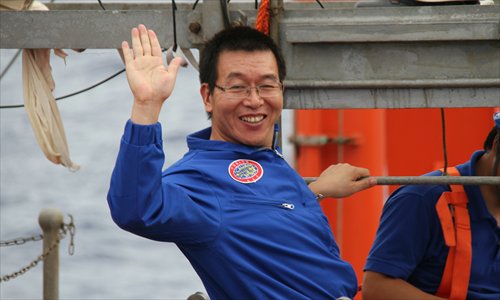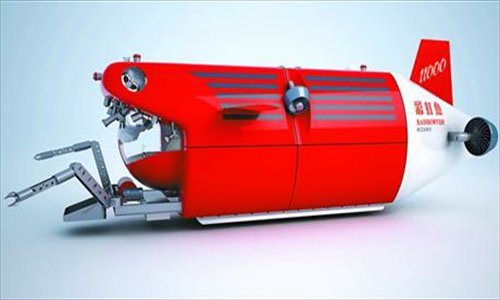Hero of Jiaolong seeks new frontiers of deep-sea marine science

Cui Weicheng at the test dive of Jiaolong Photos: Courtesy of Cui Weicheng

A model of the Rainbow Fish, the 11,000-meter submersible
Three years ago, Cui Weicheng, the deputy chief designer of the manned submersible Jiaolong, was one of the eight crew members who ventured down over 7,000 meters underwater, breaking the national record in the process. China Central Television gave live coverage of the dive, hailing it as "a giant leap in the development of China's deep-sea exploration technology." When Cui, along with the rest of the crew, returned to port in Qingdao, they were welcomed with flowers, cheers and waving flags in the same way Chinese astronauts were after they returned to Earth. In the Great Hall of the People in Beijing, he met President Xi Jinping, who called him a national hero.
No one could have expected that just six months later, Cui, 50 years old at the time, would call it quits, leaving the prestigious China Ship Scientific Research Center (CSSRC), where he had worked for 16 years, and the promising Jiaolong project.
But Cui said his decision was not an impulsive one. He had decided that he would attempt to build a manned submersible capable of diving to a depth of 11,000 meters, which he expects to reach the Challenger Deep, the deepest known point on earth, located in the Mariana Trench in the western Pacific Ocean, in 2019. He named the planned submersible Rainbow Fish.
Building a manned submersible capable of withstanding such pressures, along with its mothership, is not on China's official agenda, at least not in the near future. This means that to kick-start his dreams, Cui had to quit the State-run institute and seek private funding for a project that could easily swallow hundreds of millions of yuan and whose profitability is far from certain. It's as if Neil Armstrong quit NASA to build his own spaceship. It was a decision that baffled his family, colleagues and friends. "They thought I'd gone crazy," he said.
But Cui just could not wait. "Submersibles are tools for marine science. Only when China has more advanced submersibles can it keep up with developed countries in deep-sea marine science. My motivation is as simple as that," said the devoted scientist, who originally hails from the city of Haimen in East China's Jiangsu Province. After leaving the CSSRC, he joined the Shanghai Ocean University and set up a science and technology center to work with the university's marine scientists.
Having worked at a State-owned research institute, Cui said he "understand[s] what kind of problems the governmental system can solve and what it can't." While funding isn't an issue, "it can take eight to 10 years for the National Development and Reform Commission to approve a project like the construction of a mothership of the submersible, but by then it would be too late for the test dive," Cui said.
"I believe that scientists and businessmen have to work hand in hand to find a solution."
Making waves
At his new research center in Shanghai, Cui had to adjust to his new role: lobbying businessmen and local authorities to provide funding for his new project. "I often have to meet one businessman one day and talk to another one the next day, just to ensure our research won't be affected by a lack of funding," he said.
As far as the commercial feasibility of the project is concerned, Cui is confident that the submersible will make a profit, even though its main purpose is scientific research. "We can use it for marine archaeology, underwater rescue, and for shooting documentary films about the deepest spots on earth, like James Cameron did," Cui said, referring to the Canadian director who travelled 10,898 meters beneath the ocean's surface in 2012. "We can also sell tickets to businesspeople who are interested in deep-sea adventures and sightseeing," he said.
Cui reached out to Wu Xin, a businessman and his former colleague at the UK's University of Bristol in the late 1980s, where both of them were PhD candidates working in the same lab. Wu, in turn, persuaded a wealthy Wenzhou businessman in the shipping industry to chip in. In less than four months, the two agreed to provide 220 million yuan in funding for the construction of the mothership Zhang Qian, which is now in full swing.
For the Rainbow Fish itself and other deep-sea landers and submersibles that will accompany the Zhang Qian, Cui had already won the endorsement of luxury Swiss watch manufacturer Blancpain and the official support of the Shanghai Municipal Government. "I'm trying to break the entire project down into different parts and find a way to fund each of them, one by one," he said.
While not everything is yet set in stone, there's one thing that Cui is sure about. "If Rainbow Fish gets to be tested, I will be the first crew member to dive into the Mariana Trench," he said.
Spiritual pursuits
As an old friend, Wu describes Cui as an idealist with a strong commitment to science. "He lives a very simple life, immersing himself in his papers all day, and almost makes no time for entertainment. He's been like this since we were colleagues back in the 1980s," Wu told the Global Times.
Despite the honors he earned as Jiaolong's deputy chief designer, he still lives in a small apartment with his wife and son in Shanghai, and has donated a large amount of his personal savings - over 2 million yuan ($319,310) - to the Rainbow Fish project.
But science is not Cui's only pursuit. Cui is also a devout Buddhist. "When I entered college, China started to embrace materialism as its chief ideology. Being a scientist, however, I like to question everything, and materialism, it seems to me, makes our society short-sighted and too reliant on instant gratification," he said.
Cui compared Eastern and Western philosophies, and found a striking compatibility between science and non-dogmatic Buddhism. "The philosophy of Buddhism can even guide us in scientific research," he said. In a published paper, Cui used Buddhist philosophy to explain the Bohr-Einstein debates, a series of public disputes about quantum mechanics between physicists Albert Einstein and Niels Bohr last century, and concluded that Buddhism can have unexpected effects on our understanding of modern theoretical science.
Newspaper headline: Into the deep